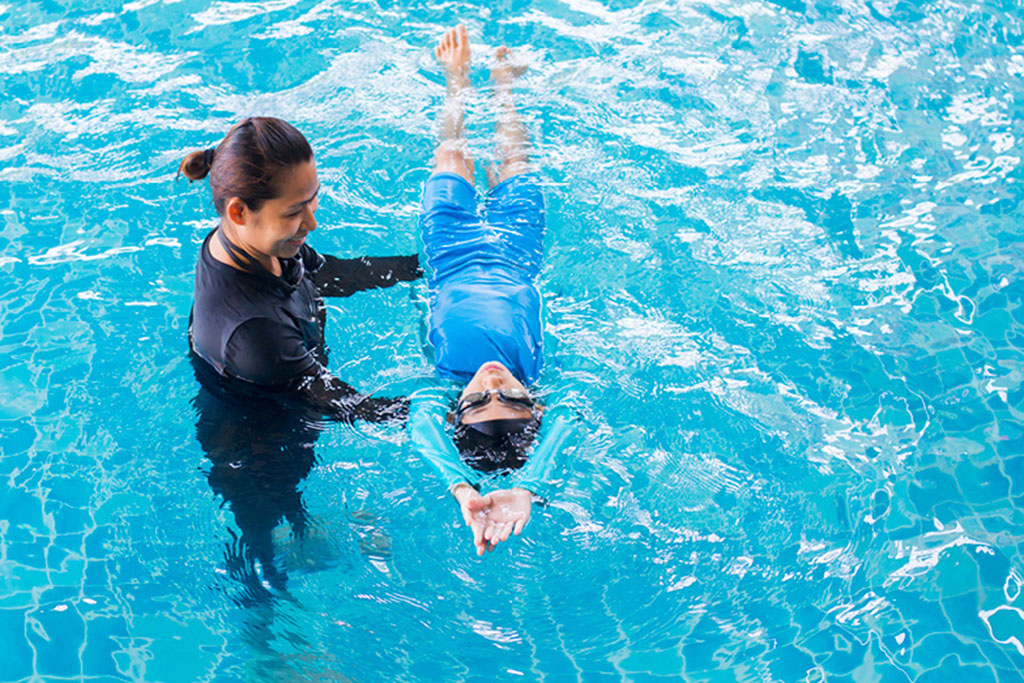Dive Into Fitness Success
If you’re seeking an enjoyable, low-impact exercise that can add some fun to your fitness, consider a routine that may cover all these perks at once: swimming.
In addition to being a wildly popular recreational activity, swimming is also highly regarded for its incredible benefits to the body. It improves muscle tone, burns fat, and, if you can access an indoor fitness center or community pool, is potentially a year-round activity. But why exactly is swimming such an impactful fitness solution? Take a deep dive into the incredible whole-body benefits of this thrilling exercise.

Checks the box
The CDC recommends that adults get at least two and a half hours of moderate physical activity and two muscle-strengthening sessions per week. Breaking up a sedentary lifestyle in this way can provide tremendous benefits to the body, namely a sharply reduced risk of serious conditions, including obesity, type 2 diabetes, many cancers, and heart disease. Swimming for five thirty-minute sessions per week can easily satisfy these health guidelines and improve your quality of life. Alternatively, if you live a busy lifestyle, you can engage in less frequent but higher-intensity sessions, such as performing freestyle laps. The CDC categorizes this as a “rigorous activity” that satisfies the physical-activity recommendations in only seventy-five minutes per week. And due to the repetitive muscle movement required to propel your body through water, swimming can also satisfy the organization’s muscle-strengthening recommendations.
Helps your heart
Heart disease is the leading cause of death in the United States, so it’s crucial to live a heart-healthier lifestyle. Thankfully, swimming itself can make a major impact, whether you enjoy a leisurely pace or intense laps in a pool. According to Harvard Medical School, the activity offers many positive cardiovascular health outcomes, such as increased blood flow to your extremities, boosted cardiac output, improved blood pressure, and a lower overall risk of heart disease. However, if you currently suffer from a heart condition, consult with your doctor about any risks and precautions to take. For instance, try to avoid swimming in very cold water; this may cause “cold shock,” or a temporary spike in your heart rate and blood pressure upon first entering the pool.
Protects your joints
Splashing around in the lanes can not only bolster your heart but also cushion your joints against excessive strain or weight. While strenuous exercises on land can apply pressure to the body, exercising in water allows the liquid to absorb your weight, which reduces the impact on major joints like your knees and the ones in your spine. This makes swimming an excellent choice for elderly individuals, especially those with joint issues like arthritis that can make other exercise routines challenging—or even punishing the next day.

Mends your mind
The CDC reports that living an active lifestyle via exercises like swimming can help reduce your risk of depression, anxiety, and dementia. Each fitness session can also provide an instant mood boost. While these advantages may be true of various regimens, the uniquely soothing sensation and calming rhythm of gliding through water can help you breathe your stresses away. This might make swimming the ultimate wellness activity.
Considerations and obstacles
Despite its incredible range of benefits to the body, swimming may not be the ideal exercise for everybody. After all, it requires a specific and potentially prohibitive piece of equipment: a swimming pool. If you don’t own a pool at home, you could access one at a local fitness center or community pool, though you may need to pay a membership fee to do so.
Another barrier that may hold you back is technique. Swimming isn’t overly complicated, but if you’ve never learned how to swim or are out of practice, you may be intimidated by the idea of doing laps and may need special training before venturing off on your own. Some people may also have physical limitations that prevent them from engaging in top-form techniques like the freestyle or butterfly.
If the access, cost, or required skills put you at odds with a swimming regimen, don’t worry—there are other low-impact solutions to try that may be more accessible to you, including hiking, cycling, and yoga. These exercises offer many of the same benefits as swimming and could also be easier to implement regularly. The key to a proper fitness routine is consistency, so choose an activity that you will enjoy and can stick to, whether or not that involves going for a swim.
Be sure to talk to your doctor before starting a new activity like swimming.


















